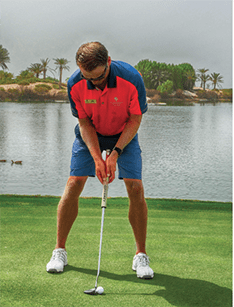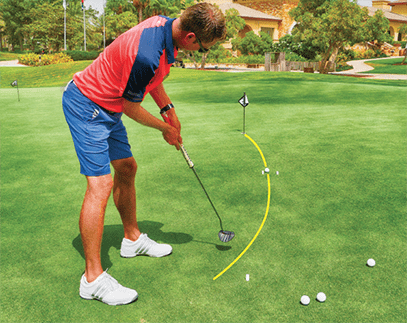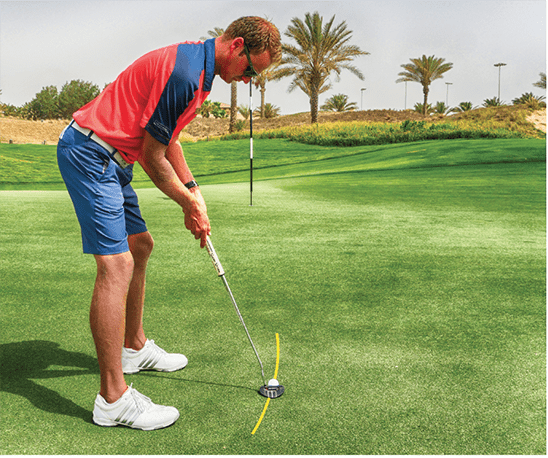The true masters of the game are successful because they hole more putts than their opponents. It’s as simple as that. Therefore, it’s time to learn the art of putting. Firstly, I recommend the specification (not type) of putter to suit your needs. You don’t need to go into great detail but ensuring the putter length is suitable for your height is a solid start. Add the correct loft and lie and you have a comprehensive fit.
You will notice here that I have a substantial forward pelvic tilt. I often see amateurs standing too close to the ball and therefore too upright, causing an imbalance to their putting stroke. I don’t prescribe to the notion that the putter should be swung on a straight line back and through the ball. The putter has a lie angle and therefore is manufactured to swing freely on an arc. So don’t get caught up on the ‘straight line syndrome’ as it will result in a stroke manipulated by the hands with less flow.

My elbows are now forced to the sides of my abdominals which, with the shaft of the putter, form a clean letter Y. Notice that my eyes are slightly inside the ball, not directly over the golf ball. Once again the correct distance from the ball can help you achieve this.
Typically, the face of a modern putter will have an average loft of three degrees so don’t get too fixed on the idea of stroking up on the ball, as you will run the risk of excessive wrist action and poor contact.
Arguably the most important note here, however, is that my hands are tension free. You should be applying pressure similar to what you would use to squeeze toothpaste from its tube.
The stroke itself should be relatively compact with a fast tempo. Keep your head rock steady and accelerate through the ball until you hear the sound of the ball dropping into the cup.
Most amateurs will struggle to get the ball closer than 20ft from the hole with their approach shot. With this in mind, becoming skilled at ‘lag’ putting is helpful to avoid several three-putts on the greens.
All you need on the practice green is a handful of tee pegs which should be fixed around the hole in a semi-circle.
Take seven big steps away from the hole and you should find yourself approximately 20ft away from it.
Place one tee down at this point using as a marker/starting point. Now stroke five balls towards the hole at a time, counting how many you leave inside your semi-circle.
Repeat the drill a further three times giving you a total of 20 putts – sufficient for the average number that you will hit from that range on the golf course. This is a simple exercise but crucially offers measurable progress if applied consistently within your practice time.
 Choose a sloping putt from approximately 15ft. Place a tee-peg as a marker/starting point and another two the width of your putter head at the apex of the slope.
Choose a sloping putt from approximately 15ft. Place a tee-peg as a marker/starting point and another two the width of your putter head at the apex of the slope.
Using five balls, and with the same repetitions as before, aim to roll each ball through the gateway of tee-pegs at the perfect pace.
This will require patience as combining the line with the speed to make the putt is challenging. If you include this in your practice routine then the numbers should speak for themselves.







